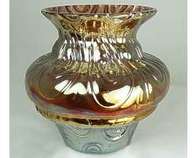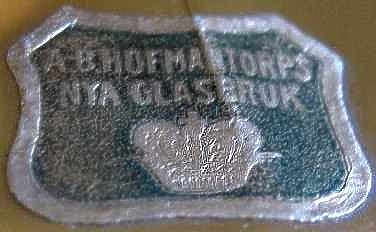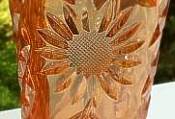Other Nordic Makers
Sweden
Fåglaviks Glasbruk
|
Faglaviks Glass Works (Fåglaviks Glasbruk) was founded in 1874 by Anders Magnus Andersson – a realisation of a long-held dream. It used local peat for fuel, local sand deposits and railway links. By the early 1900s, Faglaviks was among the top five Swedish glass works … and among its output was Carnival Glass. In our research into Carnival Glass made in the Nordic countries, we discovered the story of Faglaviks, and its contribution to the Carnival Glass scene. It is a major piece in our understanding of Carnival Glass that was made in Sweden, and more is still being uncovered. Click on the picture, left, to see the amazing patterns, shapes and colours made by Fabulous Faglaviks. |
Elme Glasbruk
|
Founded in 1917, Elme operated for over 60 years until its demise in 1970. It was located in Sweden’s “Kingdom of Glass”, and like other Swedish glassworks, benefitted from the railway for transport, and the availability of local timber and other raw materials. Elme made blown, engraved and pressed glass, the peak production being in the 1920s. Their Carnival is distinctive; usually it has a light amberish or lilac-amethyst base colour and a pale toffee-like iridescence. |
Hovmantorps Nya Glasbruk
|
The factory started in 1905 in Sweden in the “Kingdom of Crystal”. The name means Hovmantorps New Glassworks—inferring a previous, older works, most likely a cottage industry glass that began in the area in 1860. The factory operated until 1977, with its “heyday” in the 1920s and early 1930s, producing a wide range of glass. Our research is at a very early stage, with only a limited number of confirmed examples to study. The designs have a “deco” feel and black was been used as a base glass colour. |
Norway
Høvik (also Hövik) Glassverk
Glassmaking in Norway goes back to 1741 when, as with other glassworks in the region, immigrant craftsmen brought their skills to the developing industry. We believe that Høvik glassworks was established in 1854.
|
Household glass was the main output, usually being marked with the factory name.
In 2013, glass researcher John Hodgson discovered this boat-shaped marigold Carnival dish (on the right) with HØVIK moulded into the glass. The pattern Ingeborg, was identified from the catalogue, left. Another amazing discovery, with more to come. |
We have researched, studied, documented and photographed Carnival Glass from Finland, Sweden, and Norway over many years. The result is a series of e-books that provide the most comprehensive coverage of Carnival Glass made in that area, all in easy-to-use e-books. Check them out, along with our other Carnival Glass publications. You can buy online with Paypal and download your e-books, or have them mailed on CD.
Read and See More about Nordic Carnival Glass - click on any image.







